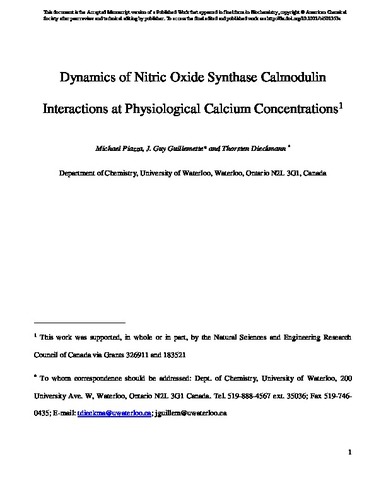| dc.contributor.author | Piazza, Michael | |
| dc.contributor.author | Guillemette, J. Guy | |
| dc.contributor.author | Dieckmann, Thorsten | |
| dc.date.accessioned | 2018-05-04 19:29:08 (GMT) | |
| dc.date.available | 2018-05-04 19:29:08 (GMT) | |
| dc.date.issued | 2015-03-24 | |
| dc.identifier.uri | http://dx.doi.org/10.1021/bi501353s | |
| dc.identifier.uri | http://hdl.handle.net/10012/13238 | |
| dc.description | This document is the Accepted Manuscript version of a Published Work that appeared in final form in Biochemistry, copyright © American Chemical Society after peer review and technical editing by publisher. To access the final edited and published work see http://dx.doi.org/10.1021/bi501353s | en |
| dc.description.abstract | The intracellular Ca2+ concentration is an important regulator of many cellular functions. The small acidic protein calmodulin (CaM) serves as a Ca2+ sensor and control element for many enzymes. Nitric oxide synthase (NOS) is one of the proteins that is activated by CaM and plays a major role in a number of key physiological and pathological processes. Previous studies have shown CaM to act like a switch that causes a conformational change in NOS to allow for the electron transfer between the reductase and oxygenase domains through a process that is thought to be highly dynamic. We have analyzed the structure and dynamics of complexes formed by peptides based on inducible NOS (iNOS) and endothelial NOS (eNOS) with CaM at Ca2+ concentrations that mimic the physiological basal (17 and 100 nM) and elevated levels (225 nM) found in mammalian cells using fluorescence techniques and nuclear magnetic resonance spectroscopy. The results show the CaM–NOS complexes have similar structures at physiological and fully saturated Ca2+ levels; however, their dynamics are remarkably different. At 225 nM Ca2+, the CaM–NOS complexes show overall an increase in backbone dynamics, when compared to the dynamics of the complexes at saturating Ca2+ concentrations. Specifically, the N-lobe of CaM in the CaM–iNOS complex displays a lower internal mobility (higher S2) and higher exchange protection compared to those of the CaM–eNOS complex. In contrast, the C-lobe of CaM in the CaM–eNOS complex is less dynamic. These results illustrate that structures of CaM–NOS complexes determined at saturated Ca2+ concentrations cannot provide a complete picture because the differences in intramolecular dynamics become visible only at physiological Ca2+ levels. | en |
| dc.description.sponsorship | Natural Sciences and Engineering Research Council of Canada [326911, 183521] | en |
| dc.language.iso | en | en |
| dc.publisher | American Chemical Society | en |
| dc.subject | Ligand-Binding Energy | en |
| dc.subject | Hydrogen-Exchange | en |
| dc.subject | Protein Dynamics | en |
| dc.subject | Conformational Plasticity | en |
| dc.subject | Rotational Diffusion | en |
| dc.subject | Catalytic Efficiency | en |
| dc.subject | Nmr-Spectroscopy | en |
| dc.subject | Domain | en |
| dc.subject | Activation | en |
| dc.subject | Peptide | en |
| dc.title | Dynamics of Nitric Oxide Synthase–Calmodulin Interactions at Physiological Calcium Concentrations | en |
| dc.type | Article | en |
| dcterms.bibliographicCitation | Piazza, M., Guillemette, J. G., & Dieckmann, T. (2015). Dynamics of Nitric Oxide Synthase–Calmodulin Interactions at Physiological Calcium Concentrations. Biochemistry, 54(11), 1989–2000. https://doi.org/10.1021/bi501353s | en |
| uws.contributor.affiliation1 | Faculty of Science | en |
| uws.contributor.affiliation2 | Chemistry | en |
| uws.typeOfResource | Text | en |
| uws.peerReviewStatus | Reviewed | en |
| uws.scholarLevel | Faculty | en |

